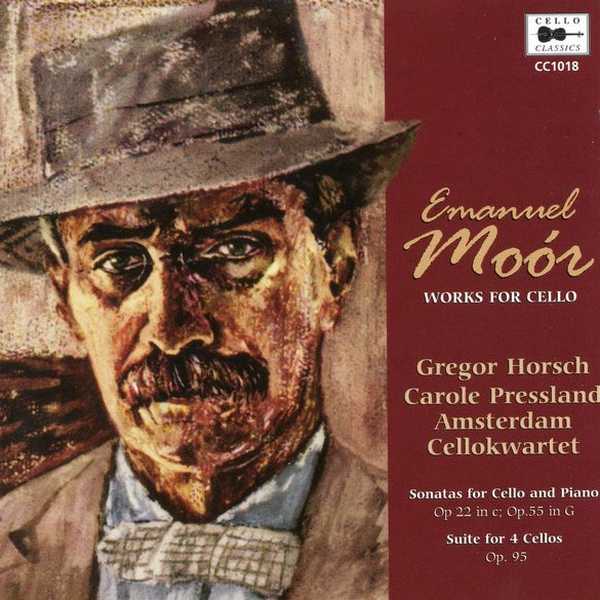
Composer: Emanuel Moór
Performer: Gregor Horsch, Carole Presland, Amsterdam Cello Quartet
Format: FLAC (tracks)
Label: Cello Classics
Catalogue: CC1018
Release: 2007
Size: 282 MB
Recovery: +3%
Scan: cover
Cello Sonata No. 2 in G Major, Op. 55
01. I. Allegro moderato
02. II. Scherzo
03. III. Adagio
04. IV. Finale. Allegro con brio
Cello Sonata in C Minor, Op. 22
05. I. Allegro maestoso
06. II. Adagio
07. III. Finale. Allegro ma non troppo
Suite for 4 Cellos, Op. 95
08. I. Andante sostenuto
09. II. Molto allegro
10. III. Adagio
11. IV. Allegro con brio
One will search the entire recorded annals of the twentieth century for mention of composer and inventor Emanuel Moór only to find no trace of him, though attentive research will reveal a few records made in the 1920s by his wife, English pianist Winifred Christie, performing on a piano Moór designed for the Bechstein firm. Despite that, Pablo Casals believed that Moór was a “genius” and that he left a prodigious 123 published compositions before the First World War knocked the wind out of his creative sails, and few composers have experienced so swift and total oblivion in the wake of his death as Moór. His fortunes have considerably improved in the twenty-first century; this Cello Classics release features German cellist Gregor Horsch in Moór’s cello sonatas along with pianist Carole Presland and in a stunning Suite for four cellos dating from 1909, played by Cellokwartet Amsterdam, of which Horsch is a member. All of the performances are sensitive, respectful to the music, and somewhat low key; not a bad strategy in music so little known and for which no established standard for interpretation exists.
This is the second recording of the Sonata, Op. 55; in comparison to the earlier performance, which was on Hungaraton, this Cello Classics recording is warmer, darker, and fuller bodied in sound. Casals had it right; the Opus 55 Sonata is unquestionably a masterpiece of post-Romantic chamber composition, the earlier Opus 22 Sonata, dating from 1891, is only slightly not so. Vaguely reminiscent of Brahms, the opening movement is rhapsodically, rather than formally, developed and has a kind of looseness that is appealing, but makes for an uneven fit with the other two movements — a searing Adagio followed by a sparkling Allegro ma non troppo. Nevertheless, it makes for highly enjoyable listening, as does the Suite for four cellos that follows. Here Moór dips into his Hungarian-Jewish heritage for some folk-like material in the first movement; however, the remainder has a kind of simplicity and directness that fall somewhere in between late Tchaikovsky and early Sibelius. How such obviously high-quality music in a classically desirable style should have remained hidden for so long is the mystery; but this is not salon music. The Suite for four cellos, Op. 95, is every bit as serious and well crafted as Tchaikovsky’s Serenade for strings. Despite Moór’s obscurity, if this appeals to you — and Tchaikovsky appeals to just about everybody — and you like the cello, chances are you will also like Cello Classics’ Emanuel Moór: Works for Cello.